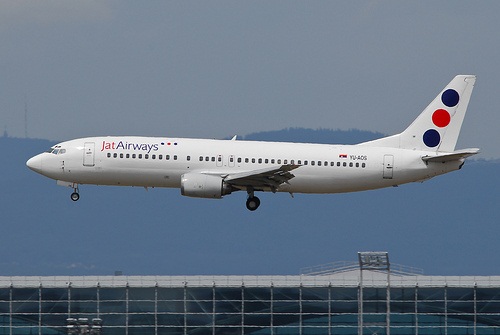The perfectly-ironed, snow white and navy dress playfully flickered against the hot tarmac. The steps to the plane were for giants and the air hostess looked like a real princess. As the only child on the scheduled flight to Amsterdam the pilot shook my hand at the door and offered to show me his “office”. As a shy 7-year-old I refused but later, encouraged by mum, I accepted. Kolja, the charming middle-aged pilot, shared his Pavlova cake with me and showed me the bewildering array of buttons around him. One of the princesses came into the cockpit with a glass of juice rather than a plastic cup. We ate the cake with a metal spoon not Mc Donald’s cutlery.
The year was 1979 and it was my first ever flight. My mum took me to Holland to meet relatives on a scheduled Yugoslav Airlines flight from Belgrade to Amsterdam.
In 1927 Aeroput (as JAT or Yugoslav Airlines used to be called) was founded and this year is celebrating its 85th birthday. This makes JAT one of the oldest airlines in Europe.
 I haven’t used Yugoslav Airlines, JAT, for a long time, tempted away by so-called “cheap tickets” on Wizz Air where you pay little for your ticket and get little by way of service in return. In order to avoid the ruthless demand for everything to be paid in Euros even though neither Serbia nor England are a part of the EC, I decided to book with JAT. And guess what - I had a pleasant surprise, my ticket was cheaper than one with Wizz Air, as JAT flies daily to Belgrade they fitted into my plans perfectly, we flew from Heathrow not the airport at the far end of a long traffic jam, and my luggage allowance was 30kg! I knew I couldn't pack half the house into 30 kg but the fact that I was not going to be exposed to check-in desk staff hunting for extra nanograms so they could charge me an astronomical excess baggage fee, made a huge difference. I could start my journey relieved of any stress or any extra demands which may pop up before I arrived in Belgrade.
I haven’t used Yugoslav Airlines, JAT, for a long time, tempted away by so-called “cheap tickets” on Wizz Air where you pay little for your ticket and get little by way of service in return. In order to avoid the ruthless demand for everything to be paid in Euros even though neither Serbia nor England are a part of the EC, I decided to book with JAT. And guess what - I had a pleasant surprise, my ticket was cheaper than one with Wizz Air, as JAT flies daily to Belgrade they fitted into my plans perfectly, we flew from Heathrow not the airport at the far end of a long traffic jam, and my luggage allowance was 30kg! I knew I couldn't pack half the house into 30 kg but the fact that I was not going to be exposed to check-in desk staff hunting for extra nanograms so they could charge me an astronomical excess baggage fee, made a huge difference. I could start my journey relieved of any stress or any extra demands which may pop up before I arrived in Belgrade.
The JU211 flight from London to Belgrade was full and surprisingly there were lots of kids who simply took over the plane. They had priority even before we boarded – at the queue during check-in, a JAT employee guided them from the queue and straight towards a check-in desk. Once on the plane they were the centre of JAT's universe. Special milk, special baby food, but for us ordinary citizens not even a drop of alcohol was offered. We, the grownups, were offered a questionable ham and tomato sandwich and warm coke, while the little Kings and Queens got the warm milk. We couldn’t have a proper drink, but the little ones got a choice of organic juices reserved for the under-sevens.
I was sitting surrounded by lots of foreigners. Next to me was a Scottish father with his son whose mum is Serbian. On my left was a young family on the way to a new life in Serbia. They didn’t speak Serbian but the father proudly announced that he could speak Slovenian. Behind me were 3 female generations – grandmother, mother and daughter - on the way to visit daddy in Belgrade. They didn’t know anything about Serbia or Belgrade but they were looking forward to exploring and learning. The youngest member of the family, the 3-year-old girl, struck up a friendship with a Serbian boy slightly older and desperate for a cuddle over the back seat. For the rest of the flight they played in the aisle and talked nonsense to each other to the amusement of the whole plane.
In front of me was a nicely dressed lady who was flying to Belgrade after a long visit to her daughter and her family in London. I asked her for the time as I don’t wear a watch. She promptly replied “12.30”.
Confused, I asked is that our time or their time. And she quickly replied:
“Our Time. Yugoslavian...”
You see, Yugoslavian time still exists, as does Yugoslav Airlines....
By Tara













